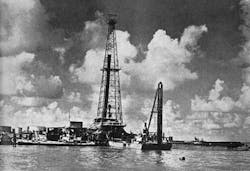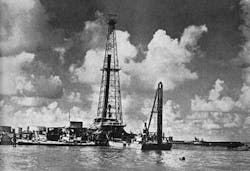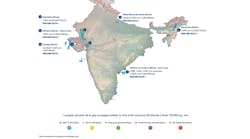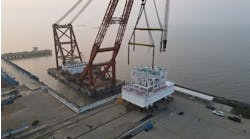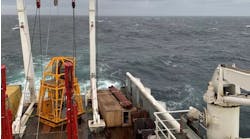Joseph A. Pratt
University of Houston
March 1938 was a memorable month in the history of the oil industry. Though little noted at the time, the first significant oil production took place in Saudi Arabia, heralding the emergence of a new center of global oil production. On March 18, 1938, Mexico stunned the oil world by announcing the expropriation of the properties of international petroleum companies, planting the seeds for a new era in which major producing nations asserted greater control over their oil. On that same day, production of oil from a well drilled by Pure Oil and Superior Oil in the Gulf of Mexico marked the birth of the offshore industry.
Yet last year, the 75th anniversary of this event went completely unnoted. Indeed, the date generally celebrated as the birth of the offshore industry has moved up nine years to Nov. 14, 1947. That day saw the completion of Kerr-McGee's Kermac 16, some 10.5 mi (17 km) from the shore off Terrebonne Parish, Louisiana. The Chamber of Commerce in Morgan City has commemorated this event with a historical marker that reads: "THE FIRST OFFSHORE OIL WELL: First producing offshore oil well out of sight of land was completed Nov. 14, 1947 in the Gulf of Mexico forty-three miles South of Morgan City, Louisiana." To the obvious criteria for "offshore," that is – in the open sea and unattached to land – was added a new qualifier, "out of sight of land." A look back at both the Creole platform and others that followed after World War II provides a glimpse of history in the making. It also suggests how difficult it has been to examine the vast changes in this formative era of offshore history and sort out who was responsible for what and when "landmark" anniversaries should be celebrated.
I came across accounts of the Creole field's pre-war development while co-authoring a book sponsored by Brown & Root and published in 1997 to help celebrate the 50th anniversary of the completion of Kermac 16. The first mention I saw of the Creole platform was in anOffshore article from October 1963 with the headline "First Well in Gulf of Mexico Was Drilled Just Twenty-five Years Ago." The fact that Brown & Root had built the platform, just as it later built Kermac 16, caught my attention. But I also stopped to think about this statement on the platform's historic significance: "It marked the oil industry's first attempt to acquire the sea legs which are now carrying it out to the edge of continental shelves around the world."
These legs were made of wood, not steel: 140 creosoted timber pilings, each 60 ft (18 m) long and driven 27 ft (8 m) into the ocean floor supported a large wooden deck measuring some 180 x 320 ft (55 x 98 m). On the platform was equipment needed to drill, but no quarters for workers. It stood in water only 14 ft (4 m) deep, and it was only a mile and a half or so from the shore. Yet these numbers do not call into questionOffshore's report that the Creole platform was "a pioneering project of the highest order." Indeed, 14 ft was well beyond the record for offshore production unattached to land, which then stood at zero. Building and operating this platform required the companies involved to find creative ways to find, drill, and produce commercial quantities of oil out in the open sea.
They used tools first developed for use onshore. Brown & Root, Pure Oil, and Superior Oil – led by Pure's I.W. Alcorn – made the most of the tools at hand. They built the first offshore platform working out in the water in a process given the descriptive name "stickbuilding." Whatever they needed came by boat to the site; whatever had to be done, they figured out how to do it by bringing equipment such as pile drivers out to sea on barges. When tools dropped into the ocean, they dived down and retrieved them. They used wood to build the structure because they knew how to build with it. Wood also was the least expensive option for constructing a drilling platform that could not be moved once it had been built, and would have to be written off and abandoned if it did not find oil at its original location.
With almost no guidelines on the wind and wave forces that a hurricane might exert on the platform, designers used onshore design standards to estimate wind forces on this offshore structure. With no systematic data on how high to place the deck above the ocean to avoid destruction by the storm surge from a powerful hurricane, they opted for a creative approach, and designed the deck of the platform to wash off during big storms. This allowed the owners to protect the extensive piling system and reconstruct the decks if need be. The location close to the shore meant that equipment could be removed when a major storm threatened. The platform had no quarters for workers; when a storm threatened, the workers simply did not go to work. Proximity to shore also allowed the company to ship oil to shore through a small diameter pipeline instead of relying on the barges generally used in the early years offshore.
Despite its nearness to shore, the Creole platform faced difficult transportation problems. Although 1.5 mi (2.4 km) out in the ocean as the pelican flew, the platform was approximately 10 mi (16 km) from Cameron, Louisiana, the nearest onshore town in the region. From there, the company shipped supplies and equipment and ferried workers to and from the platform. Workers faced an often difficult commute, traveling 1.5 to 2 hours each way in rough rides on old shrimp boats. In choppy seas, the boats might finally reach the platform only to find that workers could not be safely transferred from the boat to the deck. They then had no option but to return to shore.
Foggy weather forced even slower rides out; at times, the captain had to cut the engine to allow all onboard to listen for sounds coming from the platform. Without radios and telephones for communications between the shore and the platform, such sounds gave them at least a chance to find the platform in dense fog. On a clear day without fog, the platform might have been visible from the deserted patch of shoreline that marked the closest point to it from the beach, but it always was out of sight of land from its primary supply point, Cameron. Indeed, theOffshore article reckoned that workers faced a winding boat ride of 12 or 13 mi (19 or 21 km) to reach the platform. In short, whether an observer could see the structure from some point on the shore had little relevance to the extreme difficulties involved in finding and producing oil from the original Creole platform.
Despite these and other obstacles, the Creole drilling platform found oil and developed a field that produced an estimated 4 MMbbl of oil in its first 25 years. Although hardly large production, compared to offshore fields discovered in subsequent years, this was enough to keep the Creole field producing profitably for decades. During these years, however, it faded into the ranks of a growing number of shallow-water fields along the Texas/Louisiana coast. As the oil and gas industry moved farther offshore, the historical importance of the original Creole platform was forgotten.
World War II played a part in this process. The activity of German submarines in the Gulf and the societal imperative to win the war on two fronts moved attention away from the offshore industry. The war's end brought a rush offshore, and a wave of innovation in exploration created a revolution in offshore drilling that transformed this sector of the industry from 1946 through the early 1960s. The heart of this revolution was the search for economically viable approaches to mobile offshore drilling.
Before the war, the Creole platform had finessed the issue of mobility in the only way it could, by holding the costs of exploratory drilling down with wooden construction and reducing risks by drilling a site with a high probability of success. Had oil not been found, the companies involved probably would have written off the project, salvaged whatever wood they could from the platform, and returned to shore to lick their wounds and contemplate whether or not to go offshore again in the future. Their success in finding oil in commercial quantities posed a different choice: Would they expand the production from the field by drilling more wells from the original platform, or would they build similar structures at different locations over the field? They chose a combination of the two by initially expanding operations on the "exploration" platform and then later adding additional production platforms.
During an extraordinary burst of innovation and entrepreneurship after World War II, other companies found the resources to try different approaches. With better tools at their disposal, they took a variety of paths in their quest for greater mobility and lower costs in exploratory drilling. The fact that Kermac 16 was "out of sight of land" was much less historically significant than its contribution to the evolution of mobile drilling. Its essential contribution was the development of what became known as the "small platform with tender." This approach allowed a company to search for oil from a relatively inexpensive small platform with most supporting equipment and quarters for workers on large war surplus vessels tethered nearby with chains. These vessels could be purchased relatively cheaply then converted for use offshore. If drilling produced a dry hole, the platform could be scrapped while the tenders could be towed to another drilling site, saving substantial time and money. This innovation provided a much needed bridge between the stickbuilding of pre-war platforms and the "Gulf of Mexico" approach to the design of both mobile drilling rigs and metal jacket production platforms that had emerged by the late 1950s.
As Kerr-McGee and others developed small platforms with tenders, other companies experimented with the use of large, permanent drilling platforms resembling the permanent production platforms that came later. Though expensive, these platforms were large and sturdy; they could handle rough seas and had a long life expectancy as production platforms once they had found large reserves of oil. But if they did not find oil they could not be moved. In short, their "mobility" lasted from their journey out to the drilling location at sea until they were attached to the ocean floor with piles. The lack of success in finding oil at their original location meant a substantial loss for their owners, with no chance of recouping the loss at another site.
In 1946, Magnolia built the first of these large and expensive drilling platforms in the Gulf. Designers remembered it as one of the first offshore structures to use a metal frame to reinforce the timber piles used to support the platform. Investors and companies looking to move offshore remembered it for a different reason: its first drilling site was its last. It had to be abandoned after drilling an expensive dry hole. This led to the expansion in the use of small platforms with tenders while also intensifying the quest for truly mobile drilling rigs.
The economic incentives to develop mobile drilling were so strong that during the years from the end of World War II to the early 1960s, new technologies and designs moved from submersible rigs to semisubmersibles to jackups and finally to drilling vessels. Fierce competition yielded a stunning record of successful innovation. Only 25 years after the construction of the "drilling platform" at the Creole field in 1938, an array of proven options existed for mobile drilling at different depths and conditions. No longer did companies build exploration platforms that might become permanent production platforms after the discovery of oil. Indeed, by the early 1960s, three key sectors offshore – exploration, construction, and production – had evolved into largely separate, specialized industries.
During the same years, the design, manufacture, and launch of production platforms moved sharply toward metal templates built onshore and then installed with large specialized barges, floating cranes, and other equipment that had replaced stickbuilding. Also in place were specialized companies providing services and supplies ranging from helicopter transportation to platforms to food for offshore workers.
In short, the basic outlines of an industry well suited to the needs of the production of oil and gas in the Gulf of Mexico were in place by the early 1960s. At that time, perhaps feeling a sense of history as it approached its own 10th anniversary,Offshore published the article cited above, reminding its readers of the "pioneering project of the highest order" that had taken place on the original Creole platform. Looking back from the perspective of 1963, the discovery and production of commercial quantities of oil by a platform in the open sea, unattached to land, was a landmark in the evolution of an industry.
The young Dean McGee wrote extensively about developments in the Gulf in the 1930s and 1950s, including the importance of the Creole field. When he was not chronicling the history of the formative years offshore, this renowned geologist had a day job as the COO of Kerr-McGee, leading the company's expansion in the Gulf of Mexico. Writing in May, 1949, with recent events in the Gulf fresh in his mind, McGee noted that the original Creole platform was the first drilling platform in the Gulf of Mexico and that it produced "the first oil to be found in the open waters of the Gulf." He repeated this in slightly different language by crediting the platform with "the first production in the unprotected coastal waters." Later in the article, McGee presented a detailed discussion of his company's Kermac 16, in which he highlighted the fact that it was "the first [offshore structure] to be constructed where a platform, small in area, was used in combination with a floating drilling tender barge." He made no mention that this platform was "out of sight of land."
More than 35 years later, in 1987, the 83-year-old McGee was honored at a celebration in Morgan City marking the 40th anniversary of "the start of the offshore drilling industry." Reporters from local newspapers hailed McGee's vision in constructing "the nation's first offshore oil derrick and platform… that brought in the first offshore well in 1947," and in "developing the technology to drill in the open sea—something that had never been tried before." In an interview, McGee did not make such claims for the well. Instead, he retold a condensed version of the article he had written in 1949, allowing the newsmen present to make the sort of embellishments to be expected at such an event.
Back in the early 1950s, another authoritative voice, James Calvert, who covered events in the Gulf of Mexico for trade journals in these years, provided a corrective to the jump from "out of sight of land" to the "first offshore well drilled," a phrase repeated often enough that it already had become generally accepted. Referring to the discovery of the Creole field, Calvert wrote: "Kerr-McGee is generally credited with bringing in the first offshore well. Actually the honors should go to the Pure Oil Co. as the first to successfully operate at sea in the Gulf of Mexico."
As a member of the Hall of Fame Committee of the Offshore Energy Center, I have come to expect most important "firsts" in the offshore industry to be the collective accomplishments of numerous individuals working from different perspectives and in different companies on the same problems. The offshore fraternity as a whole in the Gulf of Mexico before the early 1960s collectively earned credit for the birth of the modern offshore industry.
Yet the Creole field has held a special place for me since I first read about it 20 years ago. I grew up near Cameron, and I relish the image of hard-working men like my dad stickbuilding the platform out in the ocean with little to work with except their own hands and ingenuity. I greatly admire the pioneering spirit of these men and others who laid the foundation for future offshore expansion. The fact that their platform was visible on a clear day from a deserted stretch of beach a mile and a half away does not diminish their accomplishment. Nor does acknowledgement of the Creole platform diminish the contributions of those who worked on Kermac 16 or in the fabrication yards building metal templates. Any number of significant firsts can be used to celebrate the birth of the modern offshore industry.
